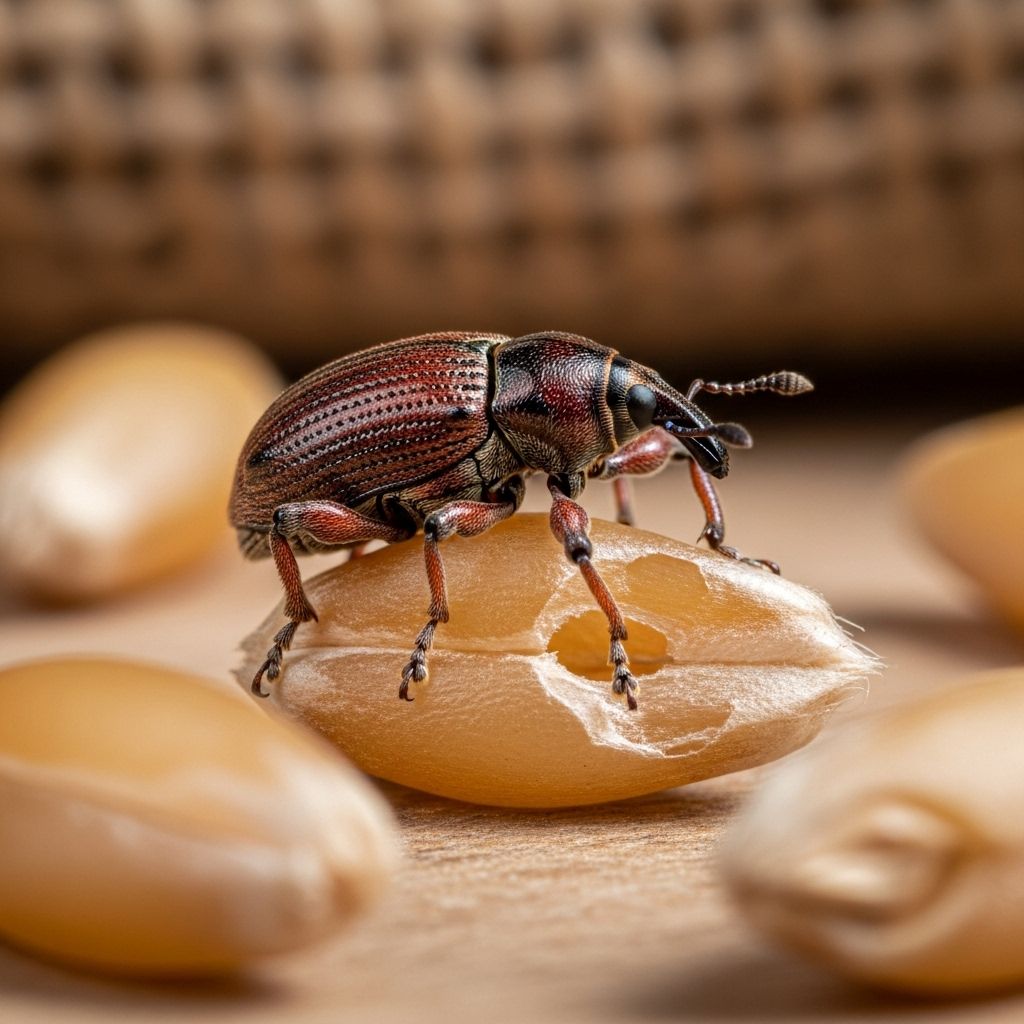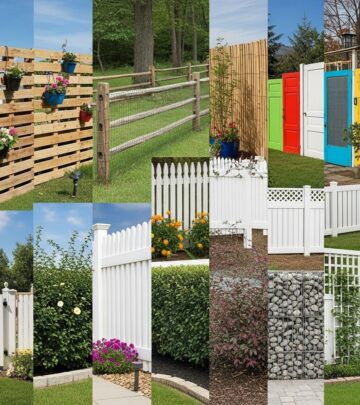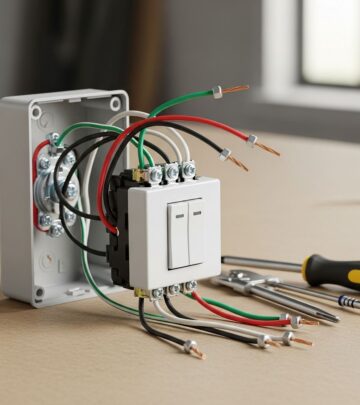How to Get Rid of Weevils: Identify, Prevent & Control
Discover effective ways to recognize, avoid, and manage these tiny garden invaders wisely.

Image: HearthJunction Design Team
What Is a Weevil? Identification, Prevention, and Control Methods
Weevils are a common household and garden pest that can cause significant damage to stored foods and plants. These small beetles are known for their distinctive elongated snouts and represent one of the largest groups of insects in the world. Understanding what weevils are, how to identify them, and implementing effective prevention and control strategies can help protect your home, pantry, and garden from these persistent pests.
What Are Weevils?
Weevils are beetles belonging to the superfamily Curculionoidea, characterized by their elongated snouts or ‘rostrums.’ They are usually small, measuring less than 6 mm (¼ inch) in length, with slender, oval-shaped bodies. These insects are part of one of the largest and most diverse groups of beetles, with over 60,000 known species worldwide.
Most weevils are herbivores, feeding on plants, seeds, nuts, and grains. Some species have evolved to become highly specialized, targeting specific plants or plant parts, while others are more generalist feeders. This dietary specialization has made certain weevil species significant agricultural and household pests.
Characteristics and Identification
Physical Appearance
Identifying weevils starts with recognizing their distinctive physical traits:
- Elongated snout: The most recognizable feature of weevils is their long, curved snout, which houses their mouthparts
- Size: Most weevils are small, typically less than half an inch long
- Body shape: They have compact, oval or cylindrical bodies
- Coloration: Weevils display colors that typically range from black and brown to more vibrant hues in some species
- Antennae: Many species have elbowed antennae that can fold into grooves along their snout
The appearance of weevils can vary significantly between species, reflecting their diverse adaptations to different environments and food sources. Some weevils are well-camouflaged, blending into their surroundings, while others may have distinctive patterns or textures on their bodies.
Common Types of Weevils
Several weevil species are commonly encountered in homes and gardens:
Pantry Weevils
- Rice Weevils (Sitophilus oryzae): Small, reddish-brown to black beetles that commonly infest stored rice, grains, and cereals
- Granary Weevils (Sitophilus granarius): Similar to rice weevils but cannot fly; they primarily infest whole grains
- Bean Weevils (Acanthoscelides obtectus): Specifically target dried beans and related legumes
Garden Weevils
- Black Vine Weevils (Otiorhynchus sulcatus): Attack ornamental plants and small fruits
- Strawberry Root Weevils (Otiorhynchus ovatus): Target strawberry plants and other garden crops
- Boll Weevils (Anthonomus grandis): Historically significant pests of cotton crops
- Acorn Weevils (Curculio spp.): Specialize in feeding on acorns and other nuts
Life Cycle and Habits
Understanding the weevil life cycle is crucial for effective pest management. Weevils undergo complete metamorphosis, progressing through four distinct life stages:
Life Cycle Stages
- Egg: Female weevils typically lay eggs inside food sources or plant tissues, providing immediate nourishment for hatching larvae
- Larva: The larval stage is typically white, grub-like, and legless. Larvae feed voraciously on their host material
- Pupa: After sufficient growth, larvae pupate, undergoing transformation into adults
- Adult: Mature weevils emerge from pupation ready to feed, mate, and continue the reproductive cycle
Habitat and Behavior
Weevils prefer warm, moist environments, though specific habitat preferences vary by species:
- Pantry weevils thrive in stored food products such as grains, rice, flour, cereals, pasta, and dried fruits
- Garden weevils live among plants, with some species laying eggs in rolled-up leaves
- Many species are nocturnal, feeding primarily at night and hiding during daylight hours
- Adult weevils can be surprisingly long-lived, with some species surviving for months or even up to a year
Signs of Weevil Infestation
Detecting weevil infestations early can prevent significant damage. Look for these common indicators:
In Food Storage Areas
- Small holes in food packaging or grains
- Presence of adult weevils crawling in pantry items
- Fine dust or powder around stored foods (caused by feeding activity)
- Webbing or clumping in dry goods
- Unpleasant, musty odor in stored foods
In Gardens and Plants
- Irregular notching or holes along leaf edges
- Stunted plant growth or wilting
- Damaged fruits, vegetables, or nuts with small entry holes
- Root damage resulting in unstable plants
- Presence of adult weevils on plants, particularly at night
Damage Caused by Weevils
The impact of weevil infestations can range from minor inconvenience to significant financial loss, depending on the species involved and the extent of the infestation.
Food Contamination
Pantry weevils can render stored foods inedible by:
- Consuming and contaminating grains, cereals, pasta, and other dry goods
- Introducing bacteria and fungi that can spoil food
- Leaving behind waste products, shed skins, and dead insects
Agricultural and Garden Damage
In gardens and agricultural settings, weevils can cause extensive damage:
- Reduced crop yields due to feeding on plants, seeds, and fruits
- Weakened plants susceptible to disease and environmental stress
- Root damage that can kill plants entirely
- Economic losses for farmers and commercial growers
Prevention Methods
Preventing weevil infestations is more effective than treating established ones. Implement these preventive measures to protect your home and garden:
Pantry Protection
- Inspect before purchasing: Check food packaging for signs of damage or infestation before buying
- Use airtight containers: Store susceptible foods in sealed glass, metal, or heavy plastic containers
- Rotate food supplies: Use older products first and avoid storing large quantities for extended periods
- Maintain cleanliness: Regularly clean pantry shelves and floors to remove spilled food
- Control temperature: Keep pantry areas cool and dry, as weevils thrive in warm, humid environments
Garden Protection
- Crop rotation: Avoid planting susceptible crops in the same location year after year
- Barrier methods: Use row covers or protective collars around vulnerable plants
- Companion planting: Grow plants that naturally repel weevils, such as garlic or marigolds
- Proper watering: Avoid overwatering, which can create favorable conditions for weevils
- Garden hygiene: Remove plant debris and fallen fruits promptly
Control and Elimination Methods
If prevention fails and weevils establish themselves, several control methods can help eliminate or manage infestations:
Non-Chemical Control
- Freezing: Place infested dry goods in the freezer for at least 72 hours to kill weevils at all life stages
- Heat treatment: Heat-treating grains and beans at 140°F (60°C) for 15 minutes can eliminate weevils
- Diatomaceous earth: This natural powder damages weevils’ exoskeletons, causing dehydration and death
- Beneficial nematodes: These microscopic organisms can control soil-dwelling weevil larvae in gardens
- Traps: Sticky traps can help monitor and reduce adult weevil populations in gardens
Chemical Control
When other methods prove insufficient, chemical interventions may be necessary:
- Insecticides: Various commercial products target weevils in different settings
- Residual sprays: These can provide longer-term protection for pantry areas
- Botanical insecticides: Plant-based products like neem oil or pyrethrin offer more natural options
Important: Always read and follow label instructions carefully when using any pesticide. Consider consulting with pest management professionals for severe infestations.
When to Call a Professional
While many weevil infestations can be managed with DIY methods, professional intervention may be necessary in certain circumstances:
- Persistent infestations that don’t respond to home treatments
- Widespread infestations affecting multiple areas of your home
- Uncertainty about the type of pest or appropriate treatment
- Large-scale agricultural or commercial infestations
Pest management professionals have access to specialized products and equipment, along with the expertise needed to address difficult infestations effectively and safely.
Frequently Asked Questions (FAQs)
Q: Are weevils harmful to humans?
A: Weevils are not harmful to humans directly. They don’t bite, sting, or transmit diseases. However, they can contaminate food supplies and cause significant damage to crops and stored goods.
Q: Can I eat food that has weevils in it?
A: While consuming a few weevils isn’t likely to cause harm, most people prefer not to eat infested food for aesthetic and hygienic reasons. Heavily infested foods should be discarded.
Q: How quickly do weevils reproduce?
A: Reproduction rates vary by species, but many weevils can complete their life cycle in 4-8 weeks under favorable conditions. A female can lay dozens or even hundreds of eggs during her lifetime.
Q: Will weevils go away on their own?
A: Weevils will not typically disappear on their own if food sources remain available. Active management is usually necessary to eliminate infestations.
Q: Can weevils infest my entire home?
A: Pantry weevils generally remain concentrated around food sources. While they can spread to other food storage areas, they don’t typically infest entire homes like some other pests.
Q: What’s the difference between weevils and other pantry pests?
A: Weevils are distinguished by their elongated snouts, while other common pantry pests like flour beetles, grain moths, and drugstore beetles have different physical characteristics. Proper identification helps determine the most effective control methods.
Conclusion
Weevils, with their distinctive snouts and specialized feeding habits, represent one of nature’s most diverse insect groups. While they play important ecological roles in natural environments, their presence in our homes and gardens is rarely welcome. By understanding weevil biology, implementing preventive measures, and taking prompt action when infestations occur, you can effectively manage these common pests and protect your food supplies and plants.
Remember that integrated pest management—combining multiple prevention and control tactics—typically provides the most sustainable and effective approach to weevil management. With vigilance and appropriate interventions, you can keep these persistent beetles at bay and minimize the damage they cause.
References
Read full bio of Srija Burman










